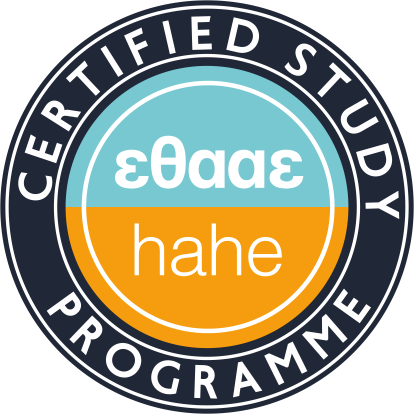Multimedia
Teaching Staff: Karydis Ioannis
Code: HY280
Course Type: Elective Course
Course Level: Undergraduate
Course Language: Greek
Semester: 5th΄
ECTS: 5
Teaching Units: 3
Lecture Hours: 2
Lab/Tutorial Hours: 2L
Total Hours: 4
E Class Page: https://opencourses.ionio.gr/courses/DDI208/
Curricula: Revamped Curriculum in Informatics from 2025
Multimedia applications are software applications that combine various media, such as text, images, sounds, three-dimensional graphics, animation and video, as well as the ability to interact with the application and determine its evolution (non-linearity). Nowadays, most modern applications are multimedia.
In the lectures, the characteristics of the media that constitute a multimedia application are studied: introduction to the concept of multimedia and the related terminology, processing of digital images and vector graphics, digitization and encoding of audio, compression and processing of digital audio, digital video and conversion of analog video to digital format, three-dimensional graphics and animation, design and development of multimedia applications.
The lab includes practical application of theory topics using open source / free software: digital image editing with Gimp, vector graphics editing with Inkscape, audio editing with Audacity, creating three-dimensional graphics and animations with Blender, video editing with Avidemux, programming interactive multimedia applications using HTML5.
Upon successful completion of the course, the student will be able to:
- Analyze the structural elements of multimedia applications,
- Use widespread free/open source applications to process and manage the media that make up multimedia such as text, images, sounds, three-dimensional graphics, animation and video,
- Design and build multimedia applications
Unit 1 - Teaching contract and introduction to multimedia
- Basic concepts of multimedia
- Building elements: characteristics and tools
Unit 2 - Digital Image
- Introduction to digital images
- Digitization
- Color models
- Bitmap images
- Vector graphics
- Hardware for digitizing images
- Hardware for processing and displaying images
- Hardware for printing images
Unit 3 - Digital Audio
- Introduction to digital audio
- Sound as a physical phenomenon
- Digital audio
- Digital music
- Hardware for digitizing and editing audio
Unit 4 - Digital Video
- Introduction to digital video
- Analog video
- Capture, size, compression, codecs and file formats
- Digital video viewing and editing software
- Hardware for digital video
Unit 5 - 3D Digital Graphics & Animation
- Introduction to 3D Graphics
- 3D Rendering
- 3D Graphics Editing Software
- Animation
- Animation Software
Unit 6th - Intellectual Property Issues
- Intellectual Property Rights
- The Case of Creative Commons
- The Support of Reasonable Infringement
- Plagiarism
- Types of Plagiarism
- Techniques for Avoiding Plagiarism
Unit 7th - Theory of Multimedia Application Development
- Introduction – Basic Processes of Multimedia Production
- Development Models for Software and Multimedia Systems
- Waterfall Model
- Incremental Build Model
- Spiral Model
- Other Adaptive and Interactive Models
- Principles of Human-Centered Design – Model LUCID
- Processes and objects of multimedia production
- Content production (the concepts of pre-production and post-production)
- Multimedia programming and execution
- The production team: specialties and skills
Unit 8th - Developing Multimedia Applications with HTML5 I
Unit 9th - Developing Multimedia Applications with HTML5 II
- “ΤΕΧΝΟΛΟΓΙΑ ΠΟΛΥΜΕΣΩΝ, Σύγχρονα Πολυμεσικά Εργαλεία”, Στυλιαράς Γ., Δήμου Β., Ζευγώλης Δ. Α., ΤΖΙΟΛΑ & ΥΙΟΙ Ο.Ε., 2019., Eudoxus code: 86053439
- “ΠΟΛΥΜΕΣΑ”, Φώτιος Λαζαρίνης, Kallipos, 2015. Eudoxus code: 320156, https://repository.kallipos.gr/handle/11419/2045
- “ΔΙΑΔΡΑΣΤΙΚΑ ΠΟΛΥΜΕΣΑ ΚΑΙ ΨΗΦΙΑΚΗ ΤΕΧΝΟΛΟΓΙΑ ΣΤΙΣ ΤΕΧΝΕΣ”, Γιάννης Δεληγιάννης, FAGOTTOBOOKS, 2007. Eudoxus code: 59359104
- Lecture slides (only for support)
- Labs (code and explanations)
Optional reading
- “Από τις σύνθετες τέχνες στα υπερμέσα και τους νέους εικονικούς-δυνητικούς χώρους. Ένα εγχειρίδιο για τον καλλιτέχνη που ασχολείται με την ψηφιακή τέχνη.”, Σαντοριναίος, Ζώη, Δημητριάδη, Διαμαντόπουλος, Μπαρδάκος, Kallipos, 2015. https://repository.kallipos.gr/handle/11419/6076
- “Τεχνολογίες συγγραφής και διαχείρισης πολυμέσων”, Χαράλαμπος Δημούλας, Kallipos, 2015. https://repository.kallipos.gr/handle/11419/4343
- In-person interactive lectures
- In-person labs
- Optional project work
- Interactive whiteboard
- Slides with animation
- Computer software for multimedia applications and the media that constitute a multimedia application
- Design and development of multimedia computer applications in HTML5
With optional assignment
- Grade = 60% assignment, 40% written exam
- Required pass condition: written exam grade >= 5/10
Without optional assignment
- Grade = 100% written exam
- Required pass condition: written exam grade >= 5/10
Back
Studies
e-mail: cs@ionio.gr




 call for applications 2025-26 (v2)
call for applications 2025-26 (v2)